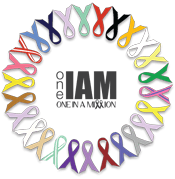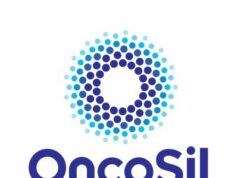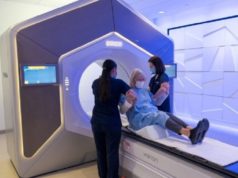
Do you know what scanxiety is? Or scanticipation? As clinicians who look after patients with cancer, interventional oncologists must realise the impact that a diagnosis of cancer, and the course of treatment, has on patients. Jim Caridi, professor of Vascular and Interventional Radiology, Tulane University, New Orleans, USA, outlines what really happens when a person travels on that difficult journey of being treated for cancer. And how, even as a physician, the most compelling advice on being a cancer warrior comes from other patients on the front lines. This is what led him to set up the oneIAM club.
It is said that a picture is worth a thousand words, but occasionally the contrary is also true. A few words can be worth a thousand pictures or images. Just ask any individual who hears the dreadful words: “You have cancer.” The typical response is a total shutdown of sensory input. While you are sitting there petrified, the word “cancer” engenders images of childhood, family, holidays, travel, hospitals, IVs, doctors, vomiting, diarrhoea, funerals, and, worst of all, life without you in it. Unrelenting images cloud your senses, and when you temporarily focus on the individual delivering the news, you see lips moving but nothing has registered. If you are fortunate, you are accompanied by someone who can recall the information you have missed.
We know that this scenario is typical, but we as providers of care must realise this sensory deprivation and take measures to ensure that any vital messages are passed on and clearly understood.
After the initial shock, you realise life as you knew it is now over. You have joined a subset of society made up of people who spend the majority of their time and efforts simply focusing on staying alive. Previous hardships and annoyances are now a mere nuisance. They have been replaced with regimented appointments, tests, scans, medication, side-effects and complications. Even if things work out in your favour, the albatross of cancer is omnipresent.
Scanziety and scanticipation are the words that come to mind. The results of one test or scan can change one’s life instantaneously. It is not unusual for affected individuals to become anxious days or even weeks prior to definitive tests. If things happen to go as planned, it is then followed by the waiting game for the results and the next course of action. This can amount to weeks of apprehension. The anticipation and waiting game is bad enough, but any disruption of this sequence—for example, a cancellation of scheduled exams—subjects the patient to even greater hardship and anxiety. This can be devastating to the patient’s psyche, and as caretakers we should ensure that these planned events and their results go unimpeded.
 It is readily apparent that those with cancer live by a separate set of rules and conditions, and their main focus is to be that “one in a million” who beats the odds. Regardless of how sensitive, knowledgeable or understanding healthcare workers may be, it is difficult for them to slip their feet completely into the cancer warrior’s shoes. The most compelling advice and experiences come from those with personal exposure. The oneIAM club or one in a million club was created to instantly open lines of communication among those with cancer so they can communicate experiences, tricks, strategies and ideas that combat the isolation, confusion and negativity that typically go along with a diagnosis of cancer. It also provides a forum for support, comfort and encouragement. It lets those affected know they are not alone and that the path they are about to travel has been walked by many. And if they heed what the many have to say, their travels will be less stressful and more agreeable.
It is readily apparent that those with cancer live by a separate set of rules and conditions, and their main focus is to be that “one in a million” who beats the odds. Regardless of how sensitive, knowledgeable or understanding healthcare workers may be, it is difficult for them to slip their feet completely into the cancer warrior’s shoes. The most compelling advice and experiences come from those with personal exposure. The oneIAM club or one in a million club was created to instantly open lines of communication among those with cancer so they can communicate experiences, tricks, strategies and ideas that combat the isolation, confusion and negativity that typically go along with a diagnosis of cancer. It also provides a forum for support, comfort and encouragement. It lets those affected know they are not alone and that the path they are about to travel has been walked by many. And if they heed what the many have to say, their travels will be less stressful and more agreeable.
In this regard a unifying one in a million logo was created to include all cancers. Although cancers may vary in type and location, they share many of the same problems and hurdles and the approach to success is usually the same. The oneIAM club’s logo and intent—whether in person or on social media (the club has a Facebook page)—is to identify and recognise members of the club, thereby providing an instant forum for camaraderie and the exchange of useful information and experiences. This is particularly relevant now when medicine has relegated much of its role to computers and ancillary personnel. They cannot and do not replace personal experiences. Such aids as B vitamins for neuropathy, ice for mucositis, turmeric for liver dysfunction and exercise for fatigue and depression come from the experience of members and are often not communicated by medical personnel.
As a member of the oneIAM club, I am well aware of the pain, misfortune and hardships experienced by many of its members. I am also aware that I am not alone and that there is strength in numbers. The sharing of positive experiences, successes, strategies, reassurance and support can result in a more positive and even fruitful journey. Because of the assistance of other members before me I have been able to persevere, remain positive and return the favour to others.
The oneIAM members may not have asked to join this club but together we can change and influence the lives of those with cancer for a more encouraging, optimistic and productive journey.
Jim Caridi is professor of Vascular and Interventional Radiology, Tulane University, New Orleans, USA, and creator of the oneIAM club













